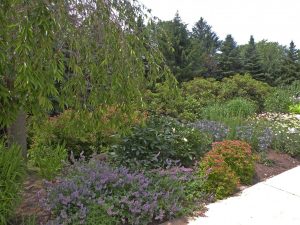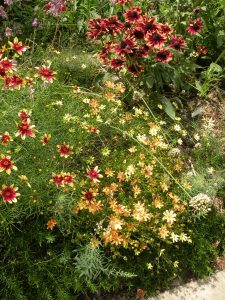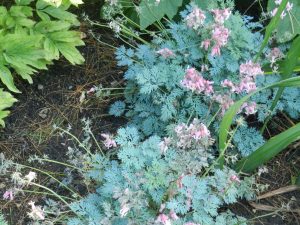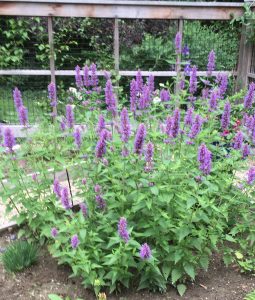
Xeriscape garden: Nepeta,Spiraea, Paeonia, Eryngium, Anthemis
If you want to design or install a colorful, low maintenance landscape, you will be looking for long blooming perennials and perennials or woody ornamentals that have colorful foliage. Hopefully, I can remind you of some old standbys while also introducing some new ones.
The Old Standbys

Achillea ‘Saucy Seduction’
I’m a fan of the yarrows and lately have been using Achillea ‘Sunny Seduction’ (yellow) and ‘Saucy Seduction’ (rose pink). Both of them grow two feet high on sturdy stems and have bright green ferny foliage. One of the things I like about ‘Saucy Seduction’ is that the flowers are still beautiful when they fade. I also like the Sassy Summer Series which is a bit taller at 26-32” high. All will bloom from June to September if you deadhead them periodically. Achillea require full sun and average to somewhat dry soil. In lean soil, Achillea is less likely to roam or fall over.

Centranthus ruber with inset of closeup
Centranthus ruber (Valerian) was commonly found in our grandmothers’ gardens and could be considered a pass-along plant because it reseeds prolifically. This trait is quite desirable in a commercial landscape because the mother plants frequently die from overwatering. The abundance of seedlings, however, negates this problem. The deadheads do not diminish the attractiveness of this perennial that blooms prolifically from June until frost. The species is a pinky-red and C. ruber ‘Albus’ is white. Centranthus usually grows two feet high in the sun but tends to flop in partial shade and too much water and thus should be considered to grow only one foot high. Unlike many perennials, Centranthus blooms as well in the shade as it does in the sun. While it prefers average to slightly dry soil, it will also grow well in slightly moist soil.

Coreopsis ‘Route 66′ and ”Sienna Sunrise’ with Echinacea ‘Cherry Brandy’
Coreopsis verticillata is probably well known to all of you but I mention it because it is a mainstay of the long blooming, low maintenance garden. There are three yellow cultivars to choose from: ‘Moonbeam’ for its lemon hue and twelve-inch height, ‘Zagreb’ for its sulphur hue and eighteen-inch height. ‘Route 66’ is harder to find but worth the search as it is yellow with a red center that flows onto the petals. The best of the pink versions is Permathread ‘Shades of Pink’. There are also red and orange cultivars now. They ask only for full sun and average to somewhat dry soil and will bloom in flushes from late May/early June through September and October, particularly if you shear them back by a third at the end of each flush.

Corydalis lutea
One of my favorite perennials, and now more available than it used to be, is Corydalis lutea, the Yellow Bleeding Heart. The scalloped, delicate, green foliage, that is similar but smaller than the foliage of Dwarf Columbine, sets off the bright yellow blossoms. This perennial is incredibly versatile. It will bloom well in shade or sun and in moist to dry soil. If it is grown in sun, it must be moist. It will reseed copiously under virtually all circumstances and you will be delighted that it does. You can never too much of it. Let it weave between other perennials and groundcovers. Only twelve inches high, it provides a lovely foliage texture as well as color from the middle of May until frost. Like the perennials mentioned above, Corydalis is never browsed by deer or rabbits.

Dicentra ‘Pink Diamonds’
Dicentra eximia and formosa, the Everblooming Bleeding Hearts, have foliage and blossoms very similar in appearance to Corydalis lutea but, in this instance, the blossoms are pink or red or white depending on the cultivar. Many of the newer cultivars have bluish-green foliage that is particularly attractive with the white or pale pink blossoms. Like Corydalis, Dicentra only grow twelve inches high and from the middle of May until frost. Be aware that slugs and deer are fond of the foliage. Grow most Dicentra in partial shade and soil that ranges from slightly dry to slightly moist. ‘Pink Diamonds’, a Walters introduction, specifically calls for a sunny, well-drained site. Similar but with white flowers and blue foliage are ‘Langtrees’ and ‘Aurora’ that I have grown in morning sun and fertile soil.
Newer Long Bloomers

Agastache ‘Blue Boa’
For a long time, Agastache (Hysssop) was thought of as strictly a southwestern plant but in the past five years, several hybrids have come to market that are quite hardy to zones 4 and 5. Happily for us, these are very long bloomers. Agastache ‘Blue Fortune’ has been around for quite a while and is one of the few that will grow well in somewhat fertile and moist conditions. It is also one of the tallest at three feet. Other good blues are ‘Blue Boa’ and ‘Little Adder’ but they prefer drier soil.

Agastache Kudos Gold
Shorter but floriferous cultivars are the Kudos Series in shades of yellow, orange, light rose, and coral, growing only eighteen to twenty-four inches high. They look great at the front of a border. Most Agastache require well-drained, somewhat lean and dry soil and all are butterfly attractors.

Phlox ‘Fashionably Early Crystal’ closeup
Phlox paniculata is definitely an old standby but some of the newer cultivars bloom earlier and longer. I’ve become a big fan of the Fashionably Early series. My Fashionably Early Crystal (white, of course) started blooming in very early June and kept reblooming into early November. I also planted some Lavender Ice but in the heat of summer it is white and didn’t become pale lavender until October when temperatures dropped. Flamingo is the other member of this series and is a lavender magenta. Supposedly these phlox grow twenty-six to thirty-two inches high but mine were only twenty-four inches high, perhaps because it was their first year. This series is known for its extreme mildew resistance.
The perennials that I have described are only a small part of the long blooming perennials palette. Rest assured, I’ll keep discovering more to share with you.


1 Comment